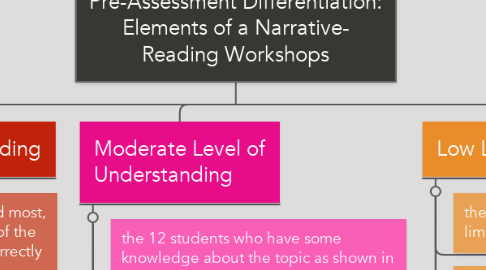
1. Moderate Level of Understanding
1.1. the 12 students who have some knowledge about the topic as shown in their score, but need to develop higher order thinking skills
1.2. Starting Point: Comprehension, Analysis, and Application
1.2.1. Reading groups divided by level and questioning based on bloom's taxonomy. Click for questioning chart
1.3. Differentiation
1.3.1. Organizers that require comparing/contrasting, classification, or rephrasing, more complex reading materials that require student to make inferences, open discussions/semi-guided discussions, group/individual conferencing. Peer and self evaluations.
1.3.2. The target for this larger group of students would be utilizing and expanding on knowledge they already possess. There would be less of a focus on terms and more of a focus on how to actively use them.
2. High Level of Understanding
2.1. the 5 students who answered most, including the most difficult, of the pre-assessment questions correctly
2.2. Starting Point: Analysis, Synthesis, Evaluation
2.2.1. Reading groups divided by level and questioning based on bloom's taxonomy. Click for questioning chart
2.3. Differentiation
2.3.1. Organizers that require students to interpret, examine, or improve material, reading materials are more complex and require students to formulate their own opinions (i.e. multi-layered characters), open discussions, group/individual conferencing. Peer and self evaluations.
2.3.2. The target for this small group would focus on expanding on a solid framework of knowledge and creating opportunities for students to form opinions and inferences unique to them. This group may move on to more complex concepts such as the "voice" in the story or tone.
3. Low Level of Understanding
3.1. the 5 students who appear to have limited knowledge about the topic
3.2. Starting Point: Knowledge and Comprehension
3.2.1. Reading groups divided by level and questioning based on bloom's taxonomy. Click for questioning chart
3.3. Differentiation
3.3.1. Graphic organizers for important terms, definition/term work-sheets, vocabulary, concise and clear reading material, guided discussions, pre-teaching, and group and individual conferencing. Peer and self evaluations.
3.3.2. The target with this group would be to get them familiar and comfortable with the main ideas, terms, and structure of narrative stories in order for them to begin developing higher order thinking skills.
3.3.2.1. I took a tip from Lilly's class in required reading. She pre-taught the lower level students a subject for a later lesson. I think that is a wonderful differentiation tool that supports self-esteem and fights labels in the classroom.

